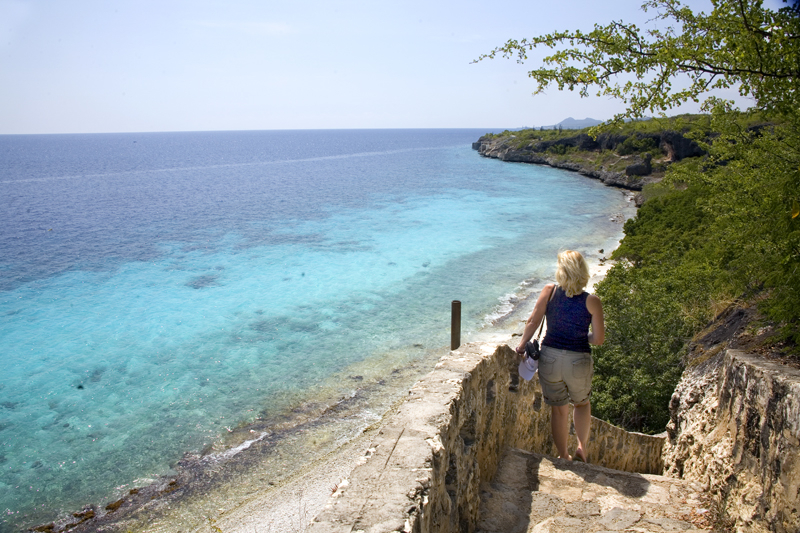 By Denise Mattia
By Denise Mattia
With parks, sanctuaries, reserves (above and below the sea) and more shy pink flamingos than sociable inhabitants, the island of Bonaire, recently made a municipality of the Netherlands, has been recognized for years as a leader in and a staunch supporter of ecology. The determination to preserve the environment is balanced successfully with tourism, because the island, just 50 miles north of Venezuela, lies outside the hurricane paths that rip through the Caribbean on a yearly basis and offers sun, sea and adventure lovers guaranteed perfect vacations.
Upon arrival, visitors are welcomed and transported to lodgings through the sea-level tract of the 25-mile long developing island. Many of the resorts, hotels and inns are clustered on the northwest side of the island, along the outskirts of the charming town of Kralendijk (KRAHL-en-dike, Dutch for coral dike). They cater to divers and have scuba operations on the premises. The Bonaire Marine Park’s $25 entrance fee, good for a year, entitles visitors to dive from shore any of the 56 marked sites on the island and the 26 buoyed sites around the adjacent, 1500-acre islet of Klein Bonaire, which is approachable by boat only. Dive shops have trips two or three times daily, which go to all the sites inaccessible by land. The fee also includes entry into the Washington Slagbaai National Park – one of the highlights on any vacationer’s bucket list.
[slideshow id=31]
The aquamarine clarity of these Caribbean waters is alluring and deceptive; you think you’re at 60 feet when, in fact, you’ve dropped below 90. The scuba guides in Bonaire will assist if necessary, but they assume divers are competent and capable of mapping out their own dive profile.
Much of the island’s marine topography follows the same contour, and the reef is virtually outside a doorstep. Divers have only to wade a short distance through calm water until they reach the terrace, an area seldom deeper than 40 feet. (This shallow section is a good place to check out scuba gear.) The terrace extends about 100 yards to the sloping reef and is mostly sea grass scattered with coral colonies and sponges. Here are conch, great barracuda, stingrays and seahorses. Manta rays glide by occasionally, just below the water’s surface. The edge of the terrace crests slightly and, from this point, divers can see the reef slanting gently down to a maximum of 200 feet.
Still, scuba isn’t the only watersport in Bonaire. The southwestern tip of the island at Lacre Point is the best area for kiteboarding. Because the trade winds blow from the east, there’s a good stiff breeze to perform aerial stunts here, and there are two schools (Kiteboarding Bonaire and the Bonaire Kite School) that provide lessons and gear.
While at the southern tip, a visit to the protected mangroves is worthwhile. At Lac Bay, guides take small groups in kayaks up the serene bay and point out the wildlife and bird population, which inhabit the dense foliage.
Washington-Slagbaai National Park is to the north. The spectacular terrain ranges from a dry, cactus-covered desert to a freshwater lake. Sometimes visitors catch a glimpse of a Lora parrot and there are plenty of iguanas sunning themselves. Against an impossibly blue sky, the salt flats of Pekelmeer to the south rise blinding-white, like great pyramids. Nearby a few nineteenth-century slave houses remain – a reminder that Bonaire imported slaves to work in Bonaire and on other islands as well.
There’s no getting close to pink flamingos at the Flamingo Sanctuary. These shy birds are protected from intruders by a saltwater lagoon. Beachcombers love picking up the polished gems at Pink Beach – they’re actually coral ground by wave action.
Touring, biking, sunning, hiking and diving work up an appetite and Bonaire’s dining spots feature island- and international cuisine. And if you haven’t planned a night dive, there’s a casino in town. Live music is featured frequently on the ocean promenade, and there are numerous bars and cafes in town, in which to dance until dawn. With all there is to see and do on the island, visitors sometimes find that the best nightspots in Bonaire are their beds.
About Denise Mattia
A writer and photographer, Denise Mattia’s works are published nationally and internationally and include all aspects of leisure travel: art , culture, resorts, spas, food and wine and sports’ activities. She's the founder of the soon to be launched Yum-Yum-Traveler, a site devoted to reviewing restaurants in addition to her travel articles from around the world. She lives and works in Manhattan, where she was born.
- Web |
- More Posts (91)
